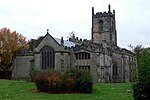A42 road (England)
All pages needing cleanupGeographic coordinate listsInfobox road instances in EnglandLists of coordinatesRoads in England ... and 2 more
Transport in LeicestershireUse British English from February 2013

The A42 is a major trunk road in the East Midlands region of the United Kingdom. It links junction 23A of the M1 motorway to junction 11 of the M42 motorway. The A42 is in effect a continuation of the M42, and its junctions are numbered accordingly. It is built to a similar standard to the M42, being a grade separated dual carriageway. The 6-mile (9.7 km) Measham and Ashby-de-la-Zouch bypass section was opened in August 1989 at a cost of £33m.
Excerpt from the Wikipedia article A42 road (England) (License: CC BY-SA 3.0, Authors, Images).A42 road (England)
A42, North West Leicestershire
Geographical coordinates (GPS) Address Nearby Places Show on map
Geographical coordinates (GPS)
| Latitude | Longitude |
|---|---|
| N 52.7548 ° | E -1.4408 ° |
Address
A42
LE65 1DS North West Leicestershire
England, United Kingdom
Open on Google Maps







